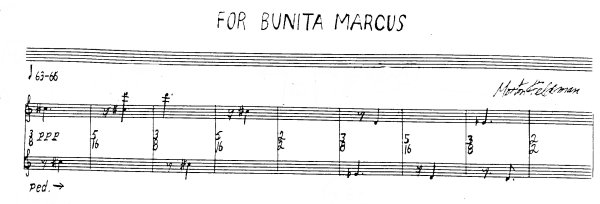I’ve started learning another late Feldman solo piano work: For Bunita Marcus. Written in 1985, it is significantly larger than Palais de mari, lasting something over an hour. I feel like I need to pace myself learning this, more so than for Palais de mari. My plan is to just start at the beginning and learn a few pages at a time, get them well established, and then look at the next chunk. In this process, I want to pay particular attention to structural articulations within the piece, stopping at these points to consolidate my progress before moving on. That way the process of learning the piece will cultivate a mental map of its overall shape.
So I’ve just pulled out the first seven or eight pages of the score as a start so that I won’t be tempted to get ahead of myself. These pages (which run about fifteen minutes or so) are completely devoted to series of phrases consisting of strings of single tones with just a very few two or three note chords (see the opening above for a sample). The pitches are always within a tight chromatic range, although with octave displacements. Over the first four pages, Feldman very gradually introduces new pitches. The first page and a half is entirely devoted to C-sharp, D, and E-flat. When E and F appear on page two, it feels like major news breaking.
These clusters of pitches unfold in phrases with a particular metrical profile: alternating bars of 3/8 and 5/16. One of the first things I had to do was to learn how to count these and then to internalize the rhythmic pattern. What worked for me was to consider all the measures as being in three, but with the first beat of the 5/16 bars cut short: 1–2–3–, 1-2–3–. After a while you just feel it as a kind of stutter or anticipation.
Phrases are separated from one another by a single bar of 2/2 meter. The lengths of the phrases vary considerably. The ones on the opening page have lengths of 4, 3, 7, 9, 2, 6, and 8 bars, for example (not including the 2/2 pauses). They have some particular profiles, too, at least in the opening few pages. They almost all open with the same rhythm (3/8 bar with attacks on the first two eighths), and many end with a common rhythm, too (3/8 bisected with two dotted-eighth attacks). Others end with expansive gestures, sweeping up through several registers from bass to treble.
The effect of all this—tight chromatic range, off-kilter meter, consistent single-note texture—is a music that is much more on edge than the lilting two-note phrases of Palais de mari. Also notably lacking here are the kinds of clearly-bounded, brief sonic images that you find in many other late Feldman works. Instead the image is drawn out, almost textural, a process moving forward.
After I got the rhythms down, a question arose: how to treat those 2/2 pauses? Specifically, the question arose: where do my hands go in between phrases? I tried putting them down during the pauses, but that didn’t feel right: too choppy. I tried leaving them up, but that wasn’t right either: too exhausting. I found that what was really key was how my attention was being deployed, and awareness of hand position was just an embodiment of that attention. I went through the score and identified those places where I felt phrases connected to each other (and hence my hands and attention should both stay up), and those places where I felt a sense of putting something down and starting over (and hence my hands and attention could be put down for a moment). The results worked for me. Now I have a middle-scale of articulation with groups of phrases chained together with attentive pauses. And when I do relax my attention, it gives me a rest so that I don’t wear myself out in this opening fifteen minutes. And it’s all tied to the felt sense of the quality of Feldman’s own attention while composing, extending the image here, dropping it and starting over there.
On page seven there’s one of what I call those “Feldman resets”: sounds that completely stop the flow and which always sound to me like Feldman resetting his music. The phrases continue for another page after this, and then the next thing begins. When I reached this point, I turned back and reworked everything, playing just this first seven-plus pages for a few days before diving into the challenging music to come. I’ll continue to work this way through this piece that feels a bit like a journey through a vast unexplored country: travel a bit to a landmark, then double back and do a more detailed survey of the flora and fauna before moving on. As strange and inappropriate a metaphor as it seems for late Feldman, the process reminds me a bit of those classic adventure novels I loved as a child: Journey to the center of the Earth, Mysterious island. They both have that overall structure of the epic journey, coupled with the moment-to-moment questioning of “what comes next?”


Dear James, I’ve really enjoyed reading about your thoughts and processes while learning these Feldman pieces. I’m inspired to play them myself, but I just don’t think my piano is flexible enough with its sound. When we get my wife’s from the other side of the country, though, I intend to explore new areas of touch and tone through Feldman. Thanks for writing these posts, and good luck with “for Bunita Marcus”